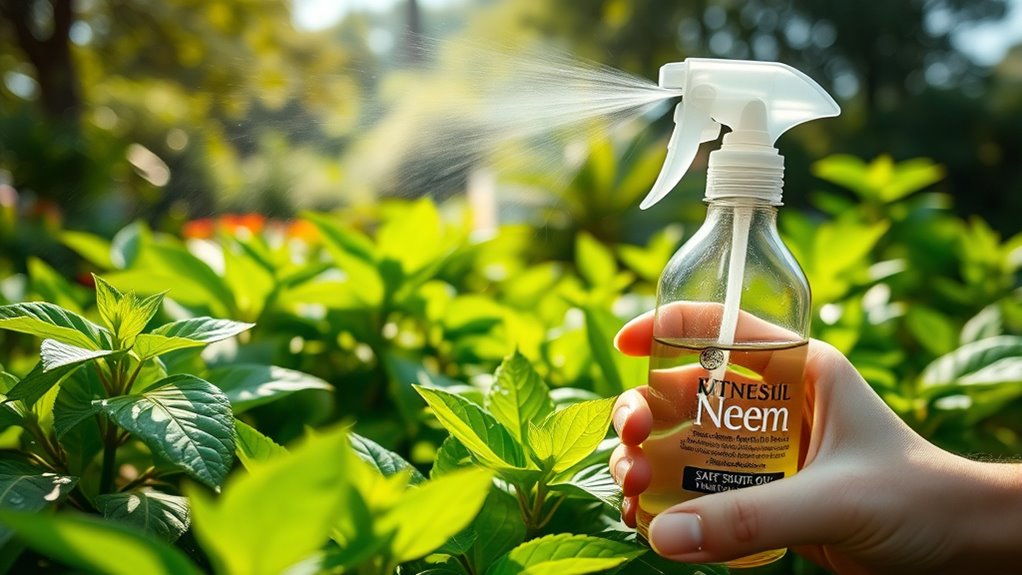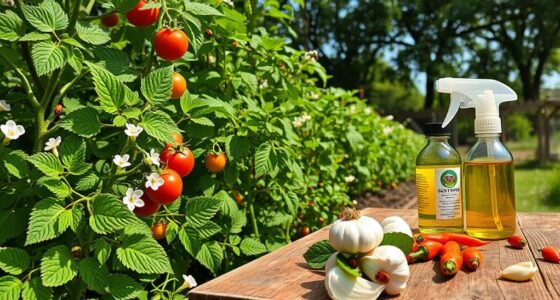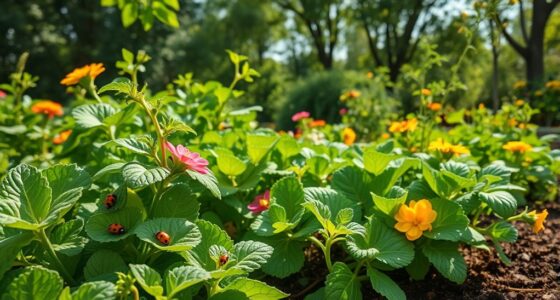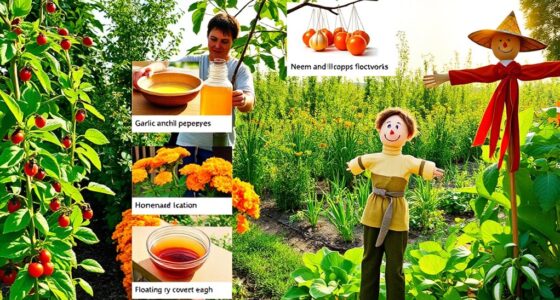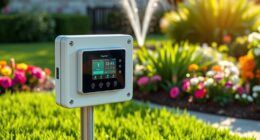To use neem oil safely on your plants, follow the manufacturer’s directions for concentration and application frequency. Dilute it with water and a drop of soap, then spray during early morning or late evening to prevent leaf burn and avoid harming beneficial insects. Always test a small area first to check for adverse reactions. If you keep these tips in mind, you’ll protect your plants effectively—more expert guidance awaits if you continue on.
Key Takeaways
- Follow manufacturer instructions for proper dilution and application frequency to prevent plant damage or pest resistance.
- Spray during early morning or late evening in cooler temperatures to avoid leaf scorch and maximize effectiveness.
- Test neem oil on a small plant area first to monitor for adverse reactions before full application.
- Cover soil and undersides of leaves to target pests while minimizing impact on beneficial insects.
- Store neem oil in a cool, dark place and use prepared solutions promptly to maintain safety and efficacy.
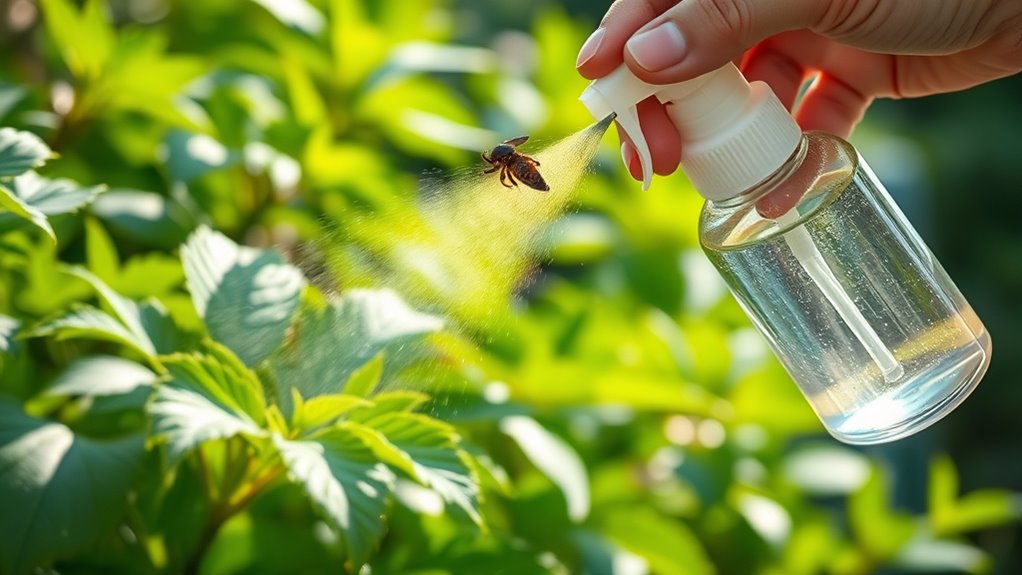
Neem oil is a popular natural solution for controlling pests and promoting healthy plants, but using it correctly is vital to avoid potential risks. When you incorporate neem oil into your pest control routine, especially within organic gardening practices, it offers a safe, eco-friendly alternative to synthetic chemicals. However, improper application can harm your plants or disrupt beneficial insects, so understanding how to use it properly is essential.
First, always follow the manufacturer’s instructions carefully. The concentration and frequency of application vary depending on the product, so reading the label ensures you use the right amount. Generally, neem oil works best when diluted with water and a small amount of soap to help it stick to plant surfaces. You should typically spray it during early morning or late evening hours, as this minimizes leaf burn and reduces the risk of harming pollinators like bees. Applying during cooler parts of the day also helps the oil adhere better and prevents rapid evaporation.
Follow manufacturer instructions, dilute properly, and spray during cooler hours to protect plants and beneficial insects.
When preparing your neem oil spray, test it on a small section of your plant first. This patch test helps identify any adverse reactions before widespread application. If the plant shows signs of stress or damage, adjust your dilution or application timing accordingly. Applying neem oil when temperatures are too high can cause leaf scorching, so avoid spraying during the hottest part of the day. Consistent, but not excessive, treatments are key—over-application can lead to resistance in pests or unintended harm to your plants.
In organic gardening, neem oil is especially valued because it’s biodegradable and less harmful to beneficial insects than many chemical alternatives. Still, you should avoid spraying when beneficial pollinators are active, such as early morning or midday. Covering the soil and undersides of leaves can help target pests more effectively while reducing impact on helpful insects. Remember, neem oil doesn’t discriminate between pests and beneficial insects if applied indiscriminately, so use it selectively and with care.
Lastly, store your neem oil in a cool, dark place away from children and pets. Proper storage preserves its effectiveness and prevents accidental exposure. By applying neem oil thoughtfully and according to guidelines, you’ll maximize its pest control benefits while supporting a healthy, organic garden. When used correctly, neem oil becomes a safe, natural tool that aligns perfectly with your goal of cultivating thriving, pest-free plants without resorting to harsh chemicals.
Frequently Asked Questions
Can Neem Oil Be Used Indoors Without Odor Issues?
You might wonder if neem oil causes indoor odor issues. When used properly, neem oil generally doesn’t produce strong smells indoors, helping maintain your indoor odor environment. To guarantee plant safety and minimize odor, dilute neem oil correctly and apply it in well-ventilated areas. This way, you keep your plants healthy without worrying about unpleasant smells, making neem oil a safe and effective choice for indoor gardening.
Is Neem Oil Safe for Edible Plants?
Let’s look at leafily lush, edible plant safety. You can use neem oil on edible plants, but you should proceed prudently. Neem oil toxicity is generally low, but it’s vital to apply it properly and wash produce thoroughly before eating. Avoid overuse, and always follow label directions. When used responsibly, neem oil can safely safeguard your edible plants without risking toxicity, helping you harvest healthy, pesticide-free produce.
How Long Does Neem Oil Residue Last on Plants?
You might wonder how long Neem Residue stays on your plants. Typically, the Residue Duration is about 7 to 14 days, depending on weather conditions and plant type. Sunlight and rain can break down Neem Residue faster, reducing its presence. To minimize residue, apply neem oil during dry weather and avoid spraying right before rain. Always wash edible plants thoroughly before harvest to guarantee safety.
Can Neem Oil Be Mixed With Other Insecticides?
Think of mixing neem oil with other insecticides like blending different flavors in a recipe—you want harmony, not chaos. Neem oil compatibility varies, so it’s essential to check insecticide mixing safety first. Always test a small batch before full application, as some chemicals may react poorly. When done carefully, combining neem oil with other insecticides can boost pest control without harming your plants.
Are There Any Plants That Are Allergic to Neem Oil?
Some plants might have a high sensitivity to neem oil, leading to allergic reactions or damage. You should test neem oil on a small part of your plant first to check for plant sensitivity. If you notice any adverse reactions like leaf curling or discoloration, it’s best to avoid using neem oil on that plant. Always monitor your plants closely to prevent allergic reactions or damage.
Conclusion
Now that you know how to use neem oil safely, you can protect your plants without turning your garden into a medieval alchemist’s lab. Remember, a little goes a long way—think of it as wielding a gentle sword rather than a warhammer. By following these steps, you’ll keep pests at bay and your garden thriving, all while channeling the wisdom of ancient herbalists. Your plants will thank you, and your green thumb will be the envy of all!
